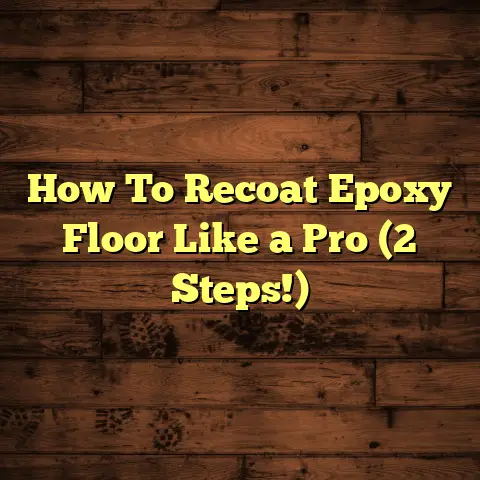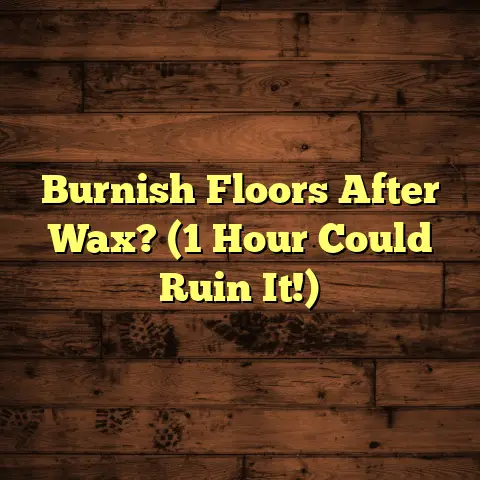Best Water Absorbents: Quick Guide? (911 Urgency!)
Warning: Water damage can escalate quickly, leading to severe structural issues, mold growth, and health hazards. It is crucial to address water-related emergencies immediately. This article serves as a quick guide to understanding water absorbents that can help mitigate damage in urgent situations.
Hey folks! As a flooring contractor, I’ve seen firsthand the devastation water damage can cause.
From burst pipes to flooded basements, it’s a nightmare scenario.
That’s why I’m writing this – to give you a quick guide to the best water absorbents, because when water’s invading, every second counts!
1. Understanding Water Absorbents
So, what exactly are water absorbents?
Simply put, they’re materials designed to soak up water quickly and efficiently, helping to minimize damage during flooding, leaks, or spills.
Think of them as sponges on steroids!
But how do they work?
It’s all about the science of absorption.
Different materials have different molecular structures that attract and hold water molecules.
Some materials, like cotton, rely on capillary action to draw water into their fibers.
Others, like superabsorbent polymers (SAPs), use chemical bonds to trap huge amounts of water.
Choosing the right absorbent is crucial. A small spill in your kitchen might only need a towel, but a flooded basement? That’s a different story, requiring industrial-strength solutions.
2. Categories of Water Absorbents
Let’s break down the types of water absorbents you’ll encounter:
Natural Absorbents
These are your classic, go-to materials:
- Cotton: Think towels, rags, and mops. Readily available and cheap, but not the most absorbent.
- Wool: Can absorb a decent amount of water but can be expensive and smelly when wet.
- Cellulose: Found in paper towels, wood shavings, and recycled paper products. Good for smaller spills, but degrades quickly when saturated.
Benefits:
- Environmentally friendly
- Relatively inexpensive
- Easy to find
Limitations:
- Lower absorption capacity
- Can be slow to absorb
- May degrade or decompose when wet
Synthetic Absorbents
Enter the world of modern chemistry!
- Superabsorbent Polymers (SAPs): These are the rockstars of water absorption. They can absorb hundreds of times their weight in water! Often found in diapers, water-absorbing gels, and some flood control products.
Benefits:
- Extremely high absorption capacity
- Fast absorption rate
- Can be engineered for specific uses
Limitations:
- Can be more expensive
- May not be biodegradable
- Some types can release water under pressure
Comparison Table: Natural vs Synthetic
| Feature | Natural Absorbents | Synthetic Absorbents |
|---|---|---|
| Absorption Capacity | Low to Moderate | Very High |
| Absorption Rate | Slow to Moderate | Fast |
| Cost | Low | Moderate to High |
| Environmental Impact | Lower | Higher |
| Durability | Low | High |
Specialty Absorbents
These are designed for specific situations and industries:
- Industrial Absorbents: Used in factories and workshops to clean up oil, chemicals, and other liquids.
- Medical Absorbents: Used in hospitals and clinics to absorb blood and other bodily fluids.
- Booms and Socks: Long, flexible tubes filled with absorbent material. Ideal for containing spills and preventing water from spreading.
3. Top Water Absorbent Products
Alright, let’s get down to specifics. Here are some of the best water absorbent products I’ve seen and used in my years as a flooring contractor:
Please note that pricing and availability can change.
1. Quick Dam Flood Bags
- Key Features: Superabsorbent polymer inside a biodegradable fabric. Activates when wet.
- Absorption Capacity: Each bag absorbs about 4 gallons of water.
- Ideal Use Cases: Flood control, leaking pipes, preventing water from entering doorways.
- Pricing and Availability: Varies by retailer, typically $20-$40 for a pack of 6. Available at most hardware stores and online.
- Customer Reviews: Generally positive, with users praising their ease of use and effectiveness.
2. WaterSorb Pillows
- Key Features: Filled with a superabsorbent polymer that quickly soaks up water.
- Absorption Capacity: Each pillow can absorb up to 2 gallons.
- Ideal Use Cases: Placing under leaky pipes, in basements, or around appliances.
- Pricing and Availability: Around $15-$25 per pillow. Available online and at some specialty stores.
- Customer Reviews: Good reviews, especially for preventing water damage in hard-to-reach areas.
3. OXYMAT Absorbent Mats
- Key Features: Multi-layered absorbent mats with a waterproof backing.
- Absorption Capacity: Varies by size, but can hold several liters of water per square meter.
- Ideal Use Cases: Placing under washing machines, dishwashers, and other appliances prone to leaks.
- Pricing and Availability: $30-$60 depending on size and quantity. Available online and at home improvement stores.
- Customer Reviews: Highly rated for their durability and ability to protect floors from water damage.
4. XSORB Universal Absorbent
- Key Features: Made from recycled cellulose fibers. Can absorb a wide range of liquids, including water, oil, and chemicals.
- Absorption Capacity: About 3-5 times its weight in water.
- Ideal Use Cases: Cleaning up spills in garages, workshops, and factories.
- Pricing and Availability: Around $20-$30 for a 25-pound bag. Available at industrial supply stores and online.
- Customer Reviews: Mixed reviews, with some users praising its versatility, while others find it less effective than SAPs for water absorption.
5. DryZ Water Removal Granules
- Key Features: A granular superabsorbent polymer that can be spread over large areas to quickly soak up water.
- Absorption Capacity: Can absorb up to 50 times its weight in water.
- Ideal Use Cases: Flooded basements, large spills, and water damage restoration.
- Pricing and Availability: Typically $50-$100 for a 5-gallon bucket. Available at water damage restoration suppliers and online.
- Customer Reviews: Very positive, with users reporting significant water removal in a short amount of time.
Product Comparison Table
| Product | Material | Absorption Capacity | Ideal Use Case | Price (Approx.) |
|---|---|---|---|---|
| Quick Dam Flood Bags | SAP & Biodegradable Fabric | 4 gallons/bag | Flood control, leaky pipes | $20-$40/6-pack |
| WaterSorb Pillows | SAP | 2 gallons/pillow | Under leaky pipes, basements | $15-$25/pillow |
| OXYMAT Absorbent Mats | Multi-layered | Several liters/m² | Under appliances | $30-$60 |
| XSORB Universal Absorbent | Recycled Cellulose | 3-5x its weight | Garages, workshops, general spills | $20-$30/25 lbs |
| DryZ Water Removal Granules | SAP | 50x its weight | Flooded basements, large spills | $50-$100/5 gal |
4. How to Use Water Absorbents in Emergencies
Okay, you’ve got your absorbents.
Now what? Here’s a step-by-step guide to deploying them effectively:
- Safety First: Before you do anything, make sure the area is safe. Turn off electricity if there’s a risk of electrocution. Wear protective gear like gloves and boots.
- Identify the Source: Stop the leak or flood if possible. This will prevent further water damage.
- Contain the Water: Use booms, socks, or sandbags to prevent the water from spreading to other areas.
- Deploy Absorbents: Place absorbent materials directly in the path of the water or over the affected area. Layering can help increase absorption.
- Monitor and Replace: Check the absorbents regularly and replace them as they become saturated.
- Ventilate: Open windows and doors to help dry out the area. Use fans to circulate air.
- Document: Take photos and videos of the damage for insurance purposes.
Strategies for Optimizing Absorption:
- Layering: Use multiple layers of absorbent materials to increase the total absorption capacity.
- Combination: Combine different types of absorbents for best results. For example, use booms to contain the water and then use granules to soak up the remaining liquid.
- Agitation: Gently agitate or stir the absorbent material to help it come into contact with more water.
Case Study:
I once helped a homeowner whose basement flooded after a heavy rainstorm.
We used Quick Dam flood bags to prevent water from entering the house through the doorway, then deployed DryZ granules to soak up the water in the basement.
Within a few hours, we had removed most of the water and were able to start the drying process.
The homeowner was incredibly grateful, as we were able to prevent significant damage to their belongings.
5. Maintenance and Disposal of Water Absorbents
So, you’ve used your water absorbents.
Now what do you do with them?
- Maintenance: Some absorbent products, like booms and socks, can be reused after drying. However, most disposable absorbents, like cellulose and SAPs, should be discarded after use.
- Disposal: Follow the manufacturer’s instructions for disposal. Some SAPs can be disposed of in the trash, while others may require special handling.
- Environmental Impact: Be mindful of the environmental impact of your disposal methods. Consider using biodegradable absorbents whenever possible.
Important Note: Never flush superabsorbent polymers down the toilet.
They can expand and clog your plumbing!
6. Additional Resources
Here are some helpful resources for dealing with water emergencies:
- FEMA (Federal Emergency Management Agency): https://www.fema.gov/
- EPA (Environmental Protection Agency): https://www.epa.gov/
- Local Emergency Services: Your local fire department or emergency management agency can provide guidance and assistance during water emergencies.
- Water Damage Restoration Companies: If you’re dealing with significant water damage, it’s best to call a professional water damage restoration company.
Conclusion
Water damage is a serious issue that demands immediate attention. By understanding the different types of water absorbents and how to use them effectively, you can minimize damage and protect your property.
Don’t wait until disaster strikes.
Prepare yourself with the right absorbents and knowledge to handle emergency situations efficiently.
Your home (and your wallet) will thank you!





